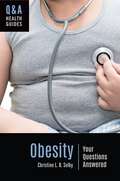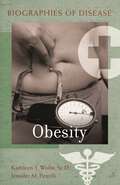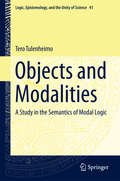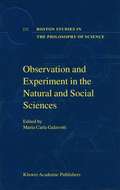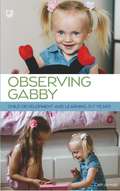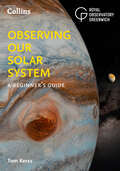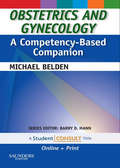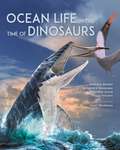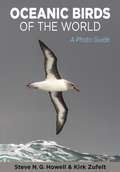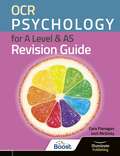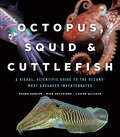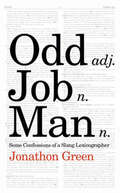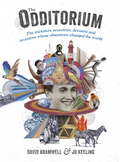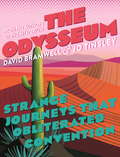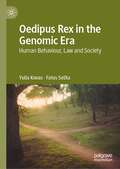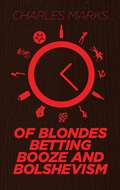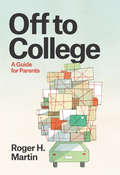- Table View
- List View
Obesity: Your Questions Answered (Q&A Health Guides)
by Christine L. SelbyThis book serves as an accessible resource for teens who want to learn more about obesity. The information and guidance it offers make it a valuable tool for young adult readers with questions or concerns about their weight.Obesity—represented by a BMI over 30—may be easy to define, but its causes and consequences and how individuals and agencies should address it are not as clear. Is obesity simply the result of eating more calories than one burns, or are other factors involved? Can an individual be obese and healthy? How does obesity affect psychological and social health? Are public health campaigns targeted at reducing obesity helping or hurting? Obesity: Your Questions Answered, a part of Greenwood's Q&A Health Guides series, answers these and other questions related to this high-interest topic. Each book in this series follows a reader-friendly question-and-answer format that anticipates readers' needs and concerns. Prevalent myths and misconceptions are identified and dispelled, and a collection of case studies illustrates key concepts and issues through relatable stories and insightful recommendations. The book also includes a section on health literacy, equipping teens and young adults with practical tools and strategies for finding, evaluating, and using credible sources of health information both on and off the internet—important skills that contribute to a lifetime of healthy decision-making.
Obesity (Biographies of Disease)
by Kathleen Y. Wolin Jennifer PetrelliAn overview written for general readers of the history, prevention, treatment, causes, and consequences of obesity.What makes obesity a disease instead of just a matter of overeating? What are the genetic and environmental factors behind it? What new breakthroughs are being developing to combat it? This concise, information-rich volume looks at these and other important questions, clearing away misconceptions about this devastating condition.Obesity explains what scientists now know about the causes and consequences of being overweight, including the latest on the links between obesity and heart disease, diabetes, some cancers, asthma, and sleep difficulties. The book pays specific attention to the problem among obese young people, who more and more are being diagnosed with chronic illnesses that used to only be seen in adults. It also reports on promising efforts to battle obesity, from medical treatments to community awareness programs.
Objects and Modalities: A Study in the Semantics of Modal Logic (Logic, Epistemology, and the Unity of Science #41)
by Tero TulenheimoThis book develops a novel generalization of possible world semantics, called ‘world line semantics’, which recognizes worlds and links between world-bound objects (world lines) as mutually independent aspects of modal semantics. Addressing a wide range of questions vital for contemporary debates in logic and philosophy of language and offering new tools for theoretical linguistics and knowledge representation, the book proposes a radically new paradigm in modal semantics. This framework is motivated philosophically, viewing a structure of world lines as a precondition of modal talk. The author provides a uniform analysis of quantification over individuals (physical objects) and objects of thought (intentional objects). The semantic account of what it means to speak of intentional objects throws new light on accounts of intentionality and singular thought in the philosophy of mind and offers novel insights into the semantics of intensional transitive verbs.
Observation and Experiment in the Natural and Social Sciences (Boston Studies in the Philosophy and History of Science #232)
by Maria Carla GalavottiThis volume is a contribution to the ongoing debate on the distinction between a ‘context of justification’ and a ‘context of discovery’. It is meant for researchers and advanced students in philosophy of science, and for natural and social scientists interested in foundational topics. Spanning a wide range of disciplines, it combines the viewpoint of philosophers and scientists and casts a new interdisciplinary perspective on the problem of observation and experimentation.
Observing Gabby: Child Development and Learning, 0-7 Years
by Cath ArnoldThis carefully structured text will be helpful for anyone teaching or studying child development particularly with the addition of video materials to view alongside the book.Mary Briggs FRSA, CMathTeach, APECS, SFHEA, FCCT, Principal Lecturer and Programme Lead for Childhood and Education (ECS and Ed Studies), Oxford Brookes University, UKThis rich account of Gabby’s early childhood development takes the reader on an inspiring journey.Shirley Allen, School of Health and Education, Middlesex UniversityI would heartily recommend this book to any early years practitioner, who wants to better understand child development, improve the quality of their child observations and to develop their skill in linking the two seamlessly.Andrea Layzell, Project Lead and Tutor, Bradford Birth to 19 Teaching School AllianceThis book is about Gabby, an inquisitive girl who leads her own learning very effectively with support from the adults in her life. The author, her grandmother, draws on seven years of data from diaries, photos and Gabby’s own writing to consider her development and learning when cared for by both her parents and grandparents. Gabby builds on her experiences with her Latvian mother, English father and her elder sister as she faces and deals with transitions as she grows up.The chapters are presented in a chronological order as a ‘running record’ going from 0-1 year right through to 6-7 years and can be analysed through a range of theories and frameworks. With chapters considering theory and the data separately the reader can reach their own conclusions on child development before exploring the author’s analyses. Each chapter also considers the relevance of Ofsted’s Intent, Implementation and Impact framework and other theories and schemas.This book about one child's early development and learning is a fascinating insight into how young children learn for those studying or working in the early years field. It includes access to an online learning centre of video clips to bring the descriptions to life and provide further insight into Gabby’s development.Dr Cath Arnold has worked in the field of Early Childhood for over 40 years, as a practitioner/teacher, researcher, lecturer and author. Her particular interests include child study; schemas and parental involvement. This is her fifth book focussing on close observation of the spontaneous actions of young children.
Observing our Solar System: A Beginner's Guide
by Tom Kerss Royal Observatory Greenwich Collins AstronomyThe sights in our Solar System are dynamic reminders of our planet's position as part of a larger neighbourhood. Study the ever-changing face of the Moon, watch the steady march of the planets against the stars, witness the thrill of a meteor shower, or the memory of a once-in-a-generation comet.
Obstetrics and Gynecology: Obstetrics And Gynecology: A Competency-based Companion: A Competency-based Companion (Competency Based Companion)
by Michael BeldenDesigned to teach you to think like a more experienced clinician, Obstetrics and Gynecology: A Competency-Based Companion, by Michael Belden, MD, places as much value on process as it does on content. This unique resource features a case-based organization that hones in on essential knowledge in obstetrics and gynecology. Its convenient pocket-sized format enables you to review the material on the go, and online access via Student Consult enhances your study of the material and exponentially boosts your reference power.Provides high-yield core information essential to rotations in a pocket-sized, portable format. Uses a color-coded system that places core information in a framework of the ACGME Core Competencies. Offers self-assessment activities throughout to promote retention and application of knowledge, including access on line to your own competency-based portfolio tools and competency-specific learning modules (Vertical Reads). Features ACGME Core Competencies enabling you to integrate evidence-based medicine, continual self-assessment, and cognizance of interpersonal skills into your daily routine. Includes features such as “Speaking Intelligently" and “Clinical Thinking" in each chapter to help you see the “big picture." Presents “Teaching Visuals"—an interactive teaching device designed to reinforce visual concepts. Equips you to perform a more in-depth review of obstetric and gynecological topics with “Clinical Entities" that link to top references in the field. Includes access to Student Consult at www.studentconsult.com, where you'll find the complete text and illustrations of the book online, fully searchable • "Integration Links" to bonus content in other Student Consult titles • Self-Assessment Competency Log • Professors Pearls that provide cases with questions and annotated answers • Vertical Reads • and much more!
Ocean Life in the Time of Dinosaurs
by Nathalie Bardet Alexandra Houssaye Stéphane Jouve Peggy VincentA richly illustrated introduction to the spectacular reptiles that swam the oceans when dinosaurs roamed the landDuring the Mesozoic era, 252 to 66 million years ago, dinosaurs ruled the land, but the ocean deeps were roiling with equally spectacular reptiles—including giant predators. This richly illustrated, authoritative, and accessible book introduces readers to the world of these fascinating marine animals, whose predecessors returned to the seas a few million years after the first vertebrates emerged from the water. As we meet ichthyosaurs, plesiosaurs, mosasaurs, and many others, we learn about the astonishing anatomical, physiological, and behavioral adaptations that enabled these reptiles to become ocean dwellers again. We also learn about their living descendants, including sea turtles and sea snakes. Featuring stunning artwork depicting these prehistoric ocean creatures and photographs of their fossil remains, this book invites readers to discover the enthralling past of marine reptiles in all their extraordinary diversity.
Ocean Life in the Time of Dinosaurs
by Nathalie Bardet Alexandra Houssaye Stéphane Jouve Peggy VincentA richly illustrated introduction to the spectacular reptiles that swam the oceans when dinosaurs roamed the landDuring the Mesozoic era, 252 to 66 million years ago, dinosaurs ruled the land, but the ocean deeps were roiling with equally spectacular reptiles—including giant predators. This richly illustrated, authoritative, and accessible book introduces readers to the world of these fascinating marine animals, whose predecessors returned to the seas a few million years after the first vertebrates emerged from the water. As we meet ichthyosaurs, plesiosaurs, mosasaurs, and many others, we learn about the astonishing anatomical, physiological, and behavioral adaptations that enabled these reptiles to become ocean dwellers again. We also learn about their living descendants, including sea turtles and sea snakes. Featuring stunning artwork depicting these prehistoric ocean creatures and photographs of their fossil remains, this book invites readers to discover the enthralling past of marine reptiles in all their extraordinary diversity.
Oceanic Birds of the World: A Photo Guide
by Howell Steve G. Kirk ZufeltA state-of-the-art photographic field guide to the world's oceanic birdsOceanic birds are among the most remarkable but least known of all birds, living at sea, far from the sight of most people. They offer unusual identification challenges—many species look similar and it can be difficult to get good views of fast-flying birds from a moving boat. The first field guide to the world's oceanic birds in more than two decades, this exciting and authoritative book draws on decades of firsthand experience on the open seas. It features clear text filled with original insights and new information and more than 2,200 carefully chosen color images that bring the ocean and its remarkable winged inhabitants to life. Never before have oceanic birds been presented in such an accessible and comprehensive way.The introduction discusses the many recent developments in seabird taxonomy, which are incorporated into the species accounts, and these accounts are arranged into groups that aid field identification. Each group and species complex has an introductory overview of its identification challenges, illustrated with clear comparative photos. The text describes flight manner, plumage variation related to age and molt, seasonal occurrence patterns, migration routes, and many other features.The result is an indispensable guide for exploring birding's last great frontier.A comprehensive, authoritative, and accessible guide to oceanic birdsCovers more than 270 speciesIncludes more than 2,200 color photos with concise captions noting key featuresFeatures careful species comparisons, overviews of the latest taxonomy, tips on how to observe and ID birds at sea, and much more
OCR Psychology for A Level & AS Revision Guide
by Cara Flanagan Jock McGintyCovering the A Level and AS, this portable-sized guide is ideal for consolidating knowledge both at home for revision, and at school as a lesson-by-lesson summary as the course progresses. // Every AS and A Level core/key study covered on one concise spread. // Evaluation points provided for the methodical issues on each study. // Links are made to areas, debates, perspectives and applications. // Covers research methods and mathematical skills. // Exam skills and techniques are reinforced with a dedicated section of advice and guidance. // Invaluable exam tips are provided throughout. // Exam-style questions provide plenty of exam practice.
Octopus, Squid, and Cuttlefish: A Visual, Scientific Guide to the Oceans’ Most Advanced Invertebrates
by Roger Hanlon Mike Vecchione Louise Allcock"Cephalopods are often misunderstood creatures. Three biologists set the record straight."—Science News Largely shell-less relatives of clams and snails, the marine mollusks in the class Cephalopoda—Greek for “head-foot”—are colorful creatures of many-armed dexterity, often inky self-defense, and highly evolved cognition. They are capable of learning, of retaining information—and of rapid decision-making to avoid predators and find prey. They have eyes and senses rivaling those of vertebrates like birds and fishes, they morph texture and body shape, and they change color faster than a chameleon. In short, they captivate us. From the long-armed mimic octopus—able to imitate the appearance of swimming flounders and soles—to the aptly named flamboyant cuttlefish, whose undulating waves of color rival the graphic displays of any LCD screen, there are more than seven hundred species of cephalopod. Featuring a selection of species profiles, Octopus, Squid, and Cuttlefish reveals the evolution, anatomy, life history, behaviors, and relationships of these spellbinding animals. Their existence proves that intelligence can develop in very different ways: not only are cephalopods unusually large-brained invertebrates, they also carry two-thirds of their neurons in their arms. A treasure trove of scientific fact and visual explanation, this worldwide illustrated guide to cephalopods offers a comprehensive review of these fascinating and mysterious underwater invertebrates—from the lone hunting of the octopus, to the social squid, and the prismatic skin signaling of the cuttlefish.
Octopus, Squid, and Cuttlefish: A Visual, Scientific Guide to the Oceans’ Most Advanced Invertebrates
by Roger Hanlon Mike Vecchione Louise Allcock"Cephalopods are often misunderstood creatures. Three biologists set the record straight."—Science News Largely shell-less relatives of clams and snails, the marine mollusks in the class Cephalopoda—Greek for “head-foot”—are colorful creatures of many-armed dexterity, often inky self-defense, and highly evolved cognition. They are capable of learning, of retaining information—and of rapid decision-making to avoid predators and find prey. They have eyes and senses rivaling those of vertebrates like birds and fishes, they morph texture and body shape, and they change color faster than a chameleon. In short, they captivate us. From the long-armed mimic octopus—able to imitate the appearance of swimming flounders and soles—to the aptly named flamboyant cuttlefish, whose undulating waves of color rival the graphic displays of any LCD screen, there are more than seven hundred species of cephalopod. Featuring a selection of species profiles, Octopus, Squid, and Cuttlefish reveals the evolution, anatomy, life history, behaviors, and relationships of these spellbinding animals. Their existence proves that intelligence can develop in very different ways: not only are cephalopods unusually large-brained invertebrates, they also carry two-thirds of their neurons in their arms. A treasure trove of scientific fact and visual explanation, this worldwide illustrated guide to cephalopods offers a comprehensive review of these fascinating and mysterious underwater invertebrates—from the lone hunting of the octopus, to the social squid, and the prismatic skin signaling of the cuttlefish.
Octopus, Squid, and Cuttlefish: A Visual, Scientific Guide to the Oceans’ Most Advanced Invertebrates
by Roger Hanlon Mike Vecchione Louise Allcock"Cephalopods are often misunderstood creatures. Three biologists set the record straight."—Science News Largely shell-less relatives of clams and snails, the marine mollusks in the class Cephalopoda—Greek for “head-foot”—are colorful creatures of many-armed dexterity, often inky self-defense, and highly evolved cognition. They are capable of learning, of retaining information—and of rapid decision-making to avoid predators and find prey. They have eyes and senses rivaling those of vertebrates like birds and fishes, they morph texture and body shape, and they change color faster than a chameleon. In short, they captivate us. From the long-armed mimic octopus—able to imitate the appearance of swimming flounders and soles—to the aptly named flamboyant cuttlefish, whose undulating waves of color rival the graphic displays of any LCD screen, there are more than seven hundred species of cephalopod. Featuring a selection of species profiles, Octopus, Squid, and Cuttlefish reveals the evolution, anatomy, life history, behaviors, and relationships of these spellbinding animals. Their existence proves that intelligence can develop in very different ways: not only are cephalopods unusually large-brained invertebrates, they also carry two-thirds of their neurons in their arms. A treasure trove of scientific fact and visual explanation, this worldwide illustrated guide to cephalopods offers a comprehensive review of these fascinating and mysterious underwater invertebrates—from the lone hunting of the octopus, to the social squid, and the prismatic skin signaling of the cuttlefish.
Octopus, Squid, and Cuttlefish: A Visual, Scientific Guide to the Oceans’ Most Advanced Invertebrates
by Roger Hanlon Mike Vecchione Louise Allcock"Cephalopods are often misunderstood creatures. Three biologists set the record straight."—Science News Largely shell-less relatives of clams and snails, the marine mollusks in the class Cephalopoda—Greek for “head-foot”—are colorful creatures of many-armed dexterity, often inky self-defense, and highly evolved cognition. They are capable of learning, of retaining information—and of rapid decision-making to avoid predators and find prey. They have eyes and senses rivaling those of vertebrates like birds and fishes, they morph texture and body shape, and they change color faster than a chameleon. In short, they captivate us. From the long-armed mimic octopus—able to imitate the appearance of swimming flounders and soles—to the aptly named flamboyant cuttlefish, whose undulating waves of color rival the graphic displays of any LCD screen, there are more than seven hundred species of cephalopod. Featuring a selection of species profiles, Octopus, Squid, and Cuttlefish reveals the evolution, anatomy, life history, behaviors, and relationships of these spellbinding animals. Their existence proves that intelligence can develop in very different ways: not only are cephalopods unusually large-brained invertebrates, they also carry two-thirds of their neurons in their arms. A treasure trove of scientific fact and visual explanation, this worldwide illustrated guide to cephalopods offers a comprehensive review of these fascinating and mysterious underwater invertebrates—from the lone hunting of the octopus, to the social squid, and the prismatic skin signaling of the cuttlefish.
Odd Job Man: Some Confessions of a Slang Lexicographer
by Jonathon GreenFor thirty years Jonathon Green has been collecting slang – the indefinable language of the gutter, the brothel, the jail, the barroom – producing a succession of dictionaries, most recently the three-volume Green's Dictionary of Slang, that have been recognised as the most comprehensive and authoritative ever compiled. In this fascinating memoir Green reveals that he first began collecting slang in the 1970s, noticing that the contemporary authorities (notably Eric Partridge) preferred the past to the present, unaware of the huge array of new slang being coined by the counter-culture. He ponders why he still does this strange, lonely job, exploring the satisfaction that can be gained by tracking down the first use of a term just encountered in one of the cheap dime novels he devours for research. The lexis leans towards pimping and prostitution, crime and imprisonment, violence and cruelty, drunken and drugged debauches: what does this say about the man who spends every day truffling for it?A fascinating look at how one man has built a lexis of 125,000 words that includes 1,740 words for sexual intercourse, 1,351 for the penis, 540 for defecation/urination, 247 for fat, 219 for vomiting and 180 for anal sex, Odd Job Man will delight all those who love the words that the conventional dictionaries leave out.
The Odditorium: The tricksters, eccentrics, deviants and inventors whose obsessions changed the world
by David Bramwell Jo Tinsley'I LOVE THE BOOK... A BRILLIANT READ' Chris Evans, Radio 2 Breakfast Show'This book, that I approached with caution, turns out to be magnificent. Tested it with the Moondog entry. Passed A+' Danny Baker, Radio 5LiveA CELEBRATION OF CURIOSITY AND OBSESSIONStep into a world of gloriously unpredictable characters such as Ivor Cutler, Quentin Crisp, Joe Orton, Reginald Bray, Ken Campbell, Screaming Lord Sutch, Sun Ra, Buckminster Fuller, Timothy Leary and Ayn Rand.The Odditorium is a playful re-telling of history, told not through the lens of its victors, but through the fascinating stories of a wealth of individuals who, while lesser-known, are no less remarkable.Throughout its pages you'll learn about the antics and adventures of tricksters, eccentrics, deviants and inventors. While their stories range from heroic failures to great hoaxes, one thing unites them - they all carved their own path through life. Each protagonist exemplifies the human spirit through their dogged determination, willingness to take risks, their unflinching obsession and, often, a good dollop of eccentricity.Learn about Reginald Bray (1879-1939), a Victorian accountant who sent over 30,000 singular objects through the mail, including himself; Muriel Howorth (1886-1971), the housewife who grew giant peanuts using atomic energy; and Elaine Morgan (1920-2013), a journalist who battled a tirade of prejudice to pursue an aquatic-based theory of human evolution, which is today being championed by David Attenborough. While many of us are content to lead a conventional life, with all of its comfort and security, The Odditorium reminds us of the characters who felt compelled to carve their own path, despite risking ostracism, failure, ridicule and madness. Outsider artists, linguists, scientists, time travellers and architects all feature in The Odditorium, each of whom risked ostracism, ridicule and even madness in pursuit of carving their own esoteric path, changing the world in wonderful ways.'BRAMWELL CLEARLY HAS AN EYE FOR THE ODDBALL AND ARCANE' The Guardian
The Odysseum: Strange journeys that obliterated convention
by David Bramwell Jo TinsleyTHE ODYSSEUM explores extraordinary journeys, pilgrimages, expeditions and meanders of the mind that helped us to figure out our place in the world. We will learn about epic trips to the bottom of the ocean, to outer space and to the deepest cave on earth ("like climbing an inverted Mount Everest") as well as micro-journeys, such as Xavier de Maistre's six-week odyssey around his bedroom and the tale of a Nazi who attempted to walk around the world without setting foot outside of his prison. Brought to you by the bestselling authors of THE ODDITORIUM and THE MYSTERIUM, this book is a call to arms to step off the beaten path and embark on your own eccentric, remarkable odyssey.
Oedipus Rex in the Genomic Era: Human Behaviour, Law and Society
by Yulia Kovas Fatos SelitaThis book explores the answers to fundamental questions about the human mind and human behaviour with the help of two ancient texts. The first is Oedipus Rex (Oedipus Tyrannus) by Sophocles, written in the 5th century BCE. The second is human DNA, with its origins around 4 billion years ago, and continuously revised by chance and evolution. With Sophocles as a guide, the authors take a journey into the Genomic era, an age marked by ever-expanding insights into the human genome. Over the course of this journey, the book explores themes of free will, fate, and chance; prediction, misinterpretation, and the burden that comes with knowledge of the future; self-fulfilling and self-defeating prophecies; the forces that contribute to similarities and differences among people; roots and lineage; and the judgement of oneself and others.Using Oedipus Rex as its lens, this novel work provides an engaging overview of behavioural genetics that demonstrates its relevance across the humanities and the social and life sciences. It will appeal in particular to students and scholars of genetics, education, psychology, sociology, and law.
Œuvres complètes de Voltaire: Questions sur l'Encyclopedie, par des amateurs (VII): Langues-Prieres (Œuvres complètes de Voltaire (Complete Works of Voltaire) #42B)
by VoltairePart of the complete works of the French philosopher, historian and social reformer, Voltaire. Addresses a broad range of subjects in religion, history, art and literature. Voltaire's longest text and neglected masterpiece. For students and scholars of the 18th-century Enlightenment.
Œuvres complètes de Voltaire: Questions sur l'Encyclopedie, par des amateurs (III): Aristote-Certain (Œuvres complètes de Voltaire (Complete Works of Voltaire) #39)
by VoltairePart of the complete works of the French philosopher, historian and social reformer, Voltaire. Addresses a broad range of subjects in religion, history, art and literature. Voltaire's longest text and neglected masterpiece. For students and scholars of the 18th-century Enlightenment.
Œuvres complètes de Voltaire: Questions sur l'Encyclopedie, par des amateurs (III): Aristote-Certain (Œuvres complètes de Voltaire (Complete Works of Voltaire) #39)
by VoltairePart of the complete works of the French philosopher, historian and social reformer, Voltaire. Addresses a broad range of subjects in religion, history, art and literature. Voltaire's longest text and neglected masterpiece. For students and scholars of the 18th-century Enlightenment.
Œuvres complètes de Voltaire: Questions sur l'Encyclopedie, par des amateurs (VII): Langues-Prieres (Œuvres complètes de Voltaire (Complete Works of Voltaire) #42B)
by VoltairePart of the complete works of the French philosopher, historian and social reformer, Voltaire. Addresses a broad range of subjects in religion, history, art and literature. Voltaire's longest text and neglected masterpiece. For students and scholars of the 18th-century Enlightenment.
Of Blondes, Betting, Booze and Bolshevism
by Charles MarksOf Blondes, Betting, Booze and Bolshevism is the ultimate male self-help manual. In Of Blondes, Betting, Booze and Bolshevism you will learn: How to meet famous pin-up girls. How to be relieved of large sums of money by famous pin-up girls. How to marry famous pin-up girls. How to win on the races. How to drink more than is good for you. How to make a quick quid by arranging for your favourite political party to dissolve. How to create a classic of contemporary English literature in the course of discussing the four pillars of bloke culture: women, gambling, drinking and politics. With this knowledge, you can go from zero to hero in just a short amount of time!
Off to College: A Guide for Parents (Chicago Guides to Academic Life)
by Roger H. MartinFor many parents, sending their child off to college can be a disconcerting leap. After years spent helping with homework, attending parent-teacher conferences, and catching up after school, college life represents a world of unknowns. What really happens during that transitional first year of college? And what can parents do to strike the right balance between providing support and fostering independence? With Off to College, Roger H. Martin helps parents understand this important period of transition by providing the perfect tour of the first year on today’s campus. Martin, a twenty-year college president and former Harvard dean, spent a year visiting five very different colleges and universities across the United States—public and private, large and small, elite and non-elite—to get an insider’s view of modern college life. He observes an advising session as a student sorts out her schedule, unravels the mysteries of roommate assignments with a residence life director, and patrols campus with a safety officer on a rowdy Saturday night. He gets pointers in freshman English and tips on athletics and physical fitness from coaches. He talks with financial aid officers and health service providers. And he listens to the voices of the first–year students themselves. Martin packs Off to College with the insights and advice he gained and bolsters them with data from a wide variety of sources to deliver a unique and personal view of the current student experience. The first year is not just the beginning of a student’s college education but also the first big step in becoming an adult. Off to College will help parents understand what to expect whether they’re new to the college experience or reconciling modern campus life with memories of their own college days.
